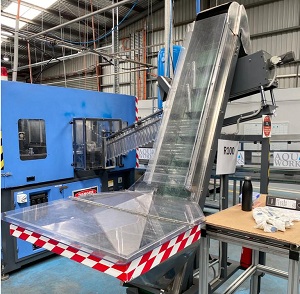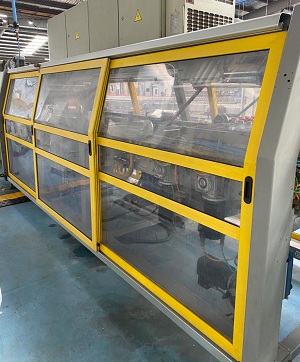Safety Machine Guard Replacement & Manufacture
The main use of machines is to protect the operators from directly coming in contact with hazardous parts or products, however, if the machine isn’t maintained well or isn’t protected well, it can still cause harm to the operator. The last thing you want is any damage or injuries caused while working.
To prevent these uncertain situations from occurring, A1 Windscreens Australia provides professional, reliable, and durable safety machine guard services that match all Occupational Health & Safety guidelines.
What Are Safety Barriers And Guards?

Safety Guards are used to protect and cover the parts of the machinery that are in motion while working from endangering the operators and individuals around.
The flying dirt in the air and the parts of the machinery in motion pose as a threat to anyone around which is why it is essential to use security guards as a protective barrier between the machinery and the operator.
In order to protect the workers and individuals around it is an essential standard set by the government that all machinery requires safety barriers. If a safety barrier isn’t used it could be very hazardous to be around and would be responsible for any amputations, damaged limbs, eye injuries, or burns.
Where do Mechanical Hazards take place?
Mechanical Hazards can occur in a lot of places, however, the most common places are:
- Point of Operation: The place where the service is carried out, for instance, the place where one cuts, sharpens, shapes, and forms using tools is the most hazardous.
- Power transmission Apparatus: The components of the machinery that transmits energy to the other part of the machine during a service, where the work is carried out is also a point considered hazardous. These components include belts, pulleys, flywheels, couplings, connecting rods, cams, chains, spindles, gears, cranks, etc.
- Other parts in Motion: The rest of the parts of the machine that are in motions such as rotating, reciprocating and transverse, etc. are all points that are considered hazardous.
Purpose & Benefits of a Safety Guard
- Protects your employees as well as your machinery during a service.
- Eliminates hazards created by points of operation, flying chips, and debris.
- It contains the flying debris, particles, heat, sparks, accidental discharge, fluids, fumes, etc.
- Reduces employee's fatigue by being automated to the procedure.
- Designed to meet the exact size and shape of your machinery.
- Prevents any accident from occurring.
- Follows the Occupational Health & Safety Guidelines.
- It provides a clear visual to the operator and other employees.
Basic Requirements for Safety Guards

- A barrier must prevent the contact of an operator's tools, hand, and limb or body part from coming in contact with the dangerous parts that are in motion.
- It should be manufactured using durable metal and should be firmly and securely fitted using the right tools during times of replacement to avoid any removal or tampering caused by the operator during service.
- It should not only prevent the operator from coming in contact with the parts in motion during service but it should also prevent any object from falling into them.
- A barrier should not create any new hazard like a jagged edge, a shear point, or an unfinished surface as it could cause laceration and might require replacement.
- It should not cause any inconvenience to the operator or hinder him from doing the work in a smooth and easy manner. A barrier is designed to make the operator's job easy and safe and not difficult and dangerous, however, if it is not doing so, it will require replacement.
- It should also make it easier and possible for the operator to regularly lubricate the machine without having to remove the barrier except during a replacement service.
5 Types of Safety Barriers
1. Guards: These physical barriers ensure that no employee comes directly in contact with the machine’s dangerous parts. This is used to prevent any on-site accidents from occurring and to do so, it is necessary for the barrier to be securely and firmly fitted each time post-replacement to avoid it from getting detached. One such type of guard is, Polycarbonate clear guards that protect the machine and product from contaminants such as dust, etc. from entering clean areas, while still allowing a clear view, to operate the machine or service. Over time, these guards may get scratched, and worn-out from constant use, but we can easily replace current guards with new ones.
2. Safeguarding device: These devices are used as a control or attachment to stop employees from accessing hazardous areas. Some of these devices are pullback, presence sensing, restraint, gates, and safety controls. These devices could execute any one of the several functions such as:
- Stopping the equipment from operating if any body part of the operator is placed near the moving part.
- The operator might need to use both his hands to control the equipment, therefore keeping the operator's body parts out of danger.
- The barrier may be synchronized with the system to avoid the operator from entering a dangerous area during the operation cycle.
3. Secondary Safeguarding: These include, awareness devices, detection devices, safe work practices, and safeguarding procedures. As compared to primary safeguarding devices, it provides a lesser degree of safety as it doesn't stop the operator from entering the hazardous areas, however, it is installed only if there are reasons of unworkability.
4. Distance/Location: To keep the dangerous parts of a machine from being accessible it is important for the machine to be rightly positioned. Before using this technique it is essential to conduct a thorough analysis of the hazards that could be caused by each machine and by accounting for any hazardous situations that could occur.
5. Warning Barriers: These types of barriers do not provide complete physical safety from the machines but they can serve as a reminder to the operator that they are entering a dangerous area.
Types of Safety Barrier Replacement
- Fixed Guards: This type of barrier is permanently fixed to the equipment and can only be detached using a specific type of tool during a replacement service while it is non-operational. It is often used to prevent the operator from accessing areas of operation that need not be handled, such as flywheels and fan blades.
- Interlocking Guards: This type of barrier shuts off automatically if the barrier is removed or opened, it is useful when the employee needs to open and access the parts with tools that are protected while cleaning or during a replacement.
- Adjustable Guards: These types of barriers can be adjusted with tools according to the size of the material that the machine is handling. It allows you to manually adjust and lock it, therefore every employee that works with these type of barriers will require thorough training on how to use it and adjust it well using the right tools, as not doing so could cause severe injuries.
- Self-Adjusting Guard: This type of barrier is similar to adjusting barrier, the only difference is that it automatically adjusts to the material's size when in use, it opens the barrier just enough to allow the access of the material and nothing else. This type of barrier is commonly used on woodworking tools and table saws.
Contact us today at 03 8795 7400 (Hallam) or 03 5924 3000 (Pakenham) for all Safety Machine Guard Replacement in Melbourne.